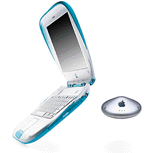Computing News
Apple’s iBook

In November 1999, Apple Computer's iBook became commonly available. This system, available in either tangerine or blueberry, represents the "consumer portable" portion of Apple's four-part product line. Like Apple's iMac, the iBook is built around the Universal Serial Bus (USB) peripheral connectivity standard. Aside from the choice of color, it is only available in one configuration.
What it has
- 300 MHz G3 processor with 512K backside level 2 cache
- One SDRAM slot, allowing up to 160 MB of RAM
- 10/100BaseT Ethernet
- 56 kbps modem
- One 12 Mbps USB port for connecting low-speed devices
- ATI Rage Mobility video controller with 4 MB SGRAM
- Mac OS 8.6 (iBooks will shortly begin shipping with Mac OS 9)
What it doesn’t have
- Serial ports (all printing is now handled through USB or Ethernet, which will require USB-to-serial converters in some cases)
- SCSI
- Floppy drive (external USB floppy drives such as the Imation SuperDisk are available)
- FireWire ports for connecting high-speed devices
- ADB port
- PC Card (PCMCIA) slots
Technical issues & recommendations
ISC does not expect there to be significant hardware-related compatibility problems with the iBook. However, the iBook will have the same software-related conflicts that any Mac OS 8.6-based workstation would have.
ISC has tested the iBook for compatibility with University-supported hardware and software. Special attention has been paid to dial-up networking and modem functionality, which has been tested using ISC’s modem testing script. The iBook is compatible with the Fall Edition of the 1999 PennConnect CD-ROM and with Penn’s supported network applications.
ISC has also recently begun testing the iBook's AirPort wireless networking capability, but testing is not yet complete.
These workstations meet ISC’s Recommended Configurations for New Lightweight Laptop Workstations, provided at least an additional 32 Mbytes of RAM are added. As always, support providers should be aware of the technical issues associated with any new workstation design.
--John Mulhern III, Senior IT Support Specialist, ISC Provider Desk
[an error occurred while processing this directive]
[an error occurred while processing this directive]